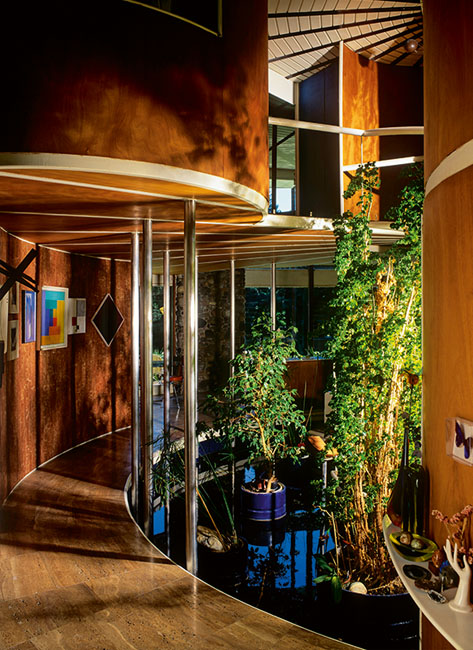Solarhaus Wermatswil
Otto Kolb
Samenvatting
In Wermatswil bij Zürich staat een rond Solarhaus: het woonhuis van architect Otto Kolb (1921-1996). Dit laatste project dat hij realiseerde, weerspiegelt zijn radicale ideeën over wonen en leven in harmonie met de natuur. In een manuscript dat Kolb schreef over het huis, citeert hij psychoanalyticus Carl Jung: ‘Het huis van de mens moet rond zijn ter herinnering aan de beschermende moederschoot (onderbewust: de baarmoeder). Maar dit was niet het enige argument om de woning rond te maken. De cirkelvorm heeft een zo klein mogelijk contactoppervlak tegen het (koude) buitenklimaat en de wind, en is in staat gedurende de hele dag zonlicht- en warmte op te vangen.’
Het ontwerp volgt het uitgangspunt dat de natuur geen rechte lijnen kent; alle ruimten, de gevel, de tuin en het zwembad hebben een ergonomische vorm. Het huis ligt deels ingegraven in een helling en bestaat uit een souterrain waarin zich onder andere een kantoor en een keur aan technische ruimten bevinden, die de ecologische principes van het huis dienen. De woonverdieping daarboven is dubbelhoog en bestaat uit een continuüm van ruimten. Blikvanger en centrum van het huis is een spiraalvormige trap die voert naar het tweede niveau: zwevend in de dubbelhoge ruimte liggen op verschillende niveaus, verbonden door hellingbanen, de slaapkamers, de badkamer en twee werkplekken. De in de trap geïntegreerde open haard met schoorsteen of Wärmeluftkammer kan afhankelijk van de haardtemperatuur voor lucht- of vloerverwarming gebruikt worden. Zonlicht komt rijkelijk het huis binnen door dubbelhoge, drielaags beglaasde ramen, die prachtig zicht bieden op de natuur rond het huis. De ramen zijn niet te openen, zodat geen warmteverlies optreedt. Zes buitendeuren zorgen voor ventilatie.
De kern van de energiehuishouding van het huis wordt gevormd door meerdere waterbassins. De binnenvijver en het buitenzwembad zijn niet alleen esthetisch fraai, maar reguleren ook het microklimaat in de woning. Het waterreservoir in het souterrain wordt door middel van op het dak geïnstalleerde zonnecollectoren opgewarmd en doet in de winter dienst als warmteopslag en in de zomer als koeling. Op de begane grond vormt het water een weelderig beplante binnenvijver die tevens fungeert als een luchtbevochtiger. Buiten, aan de zuidzijde van het huis is nog een waterbassin. Een deel wordt gebruikt als zwembad en de rest doet dienst als reflectieoppervlak om een zo gunstig mogelijke weerkaatsing van zonlicht- en warmte te bewerkstelligen. Daar waar de gevel niet uit glas bestaat is het binnenspouwblad opgebouwd uit grote stenen die gevonden werden op de bouwplaats. Daarachter zijn verwarmingsleidingen geplaatst die zijn afgedekt met 7 cm glaswolisolatie en stalen plaatmateriaal voor de gevel. De muren worden overdag door de zon en in de nacht door warmwater uit de bassins opgewarmd.



